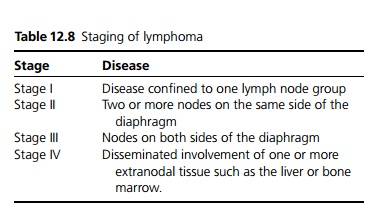Chapter: Medicine and surgery: Haematology and clinical Immunology
Hodgkin’s disease - Lymphoma
Lymphoma
Hodgkin’s disease
Definition
Hodgkin’s disease is a primary neoplastic disease of lymphoid cells characterised by proliferation of an atypical form of lymphoid cell termed Reed-Sternberg (RS) cell.
Incidence
4 per 100,000 per year.
Age
Bimodal distribution with a peak in young adults (15–34 years) and older individuals (>55).
Sex
2M : 1F
Aetiology
Infectious agents particularly Epstein Barr virus have been implicated. There is an increased incidence in pa-tients with HIV. There may be a genetic predisposition.
Pathophysiology
RS cells are a clonal proliferation of B lymphocytes arising from the germinal centres of lymph nodes. They do not produce antibodies. Some of the clinical manifestations are attributed to the production of cytokines. Oncogenes have been implicated in the pathophysiology, upregulation of bcl2 has been shown to be of prognostic significance.
Clinical features
Patients present with a painless lymphadenopathy most often within the neck. Fatigue, anorexia, pruritus and alcohol induced nodal pain may also occur. Involvement of mediastinal lymph nodes may cause cough, shortness of breath and chest pain. B symptoms may be present (fever >38◦ C, drenching night sweats, weight loss of more than 10% within 6 months). On examination there is lymph node enlargement, and hepatic or splenic enlargement. The staging of Hodgkin’s’s disease is according to the Ann Arbor system, which is suffixed by B if B symptoms are present and A if they are absent (see Table 12.8).

Microscopy
Classical Reed-Sternberg cells are large cells with a pale cytoplasm and two nuclei with prominent nucleoli said to resemble owl eyes. There are three main types of Hodgkin’s disease:
· Nodular sclerosis which affects predominantly young adults.
· Lymphocyte predominant disease seen mainly in young male adults.
· Mixed cellularity disease which mainly affects older patients.
Investigations
Diagnosis is made by lymph node biopsy. Staging requires chest X-ray, CT chest abdomen and pelvis, and bone marrow aspiration and trephine.
Management
Treatment involves chemotherapy, involved field radiotherapy or a combination depending on the stage of disease, whether the disease is bulky (defined as a mass >5–10 cm or a mediastinal mass larger than one third of the chest diameter) and the presence or absence of B symptoms.
Prognosis
The 5-year mortality from Hodgkin’s disease depends on the staging (stage I and II – 10%, stage III – 16% and stage IV – 35%).
Related Topics